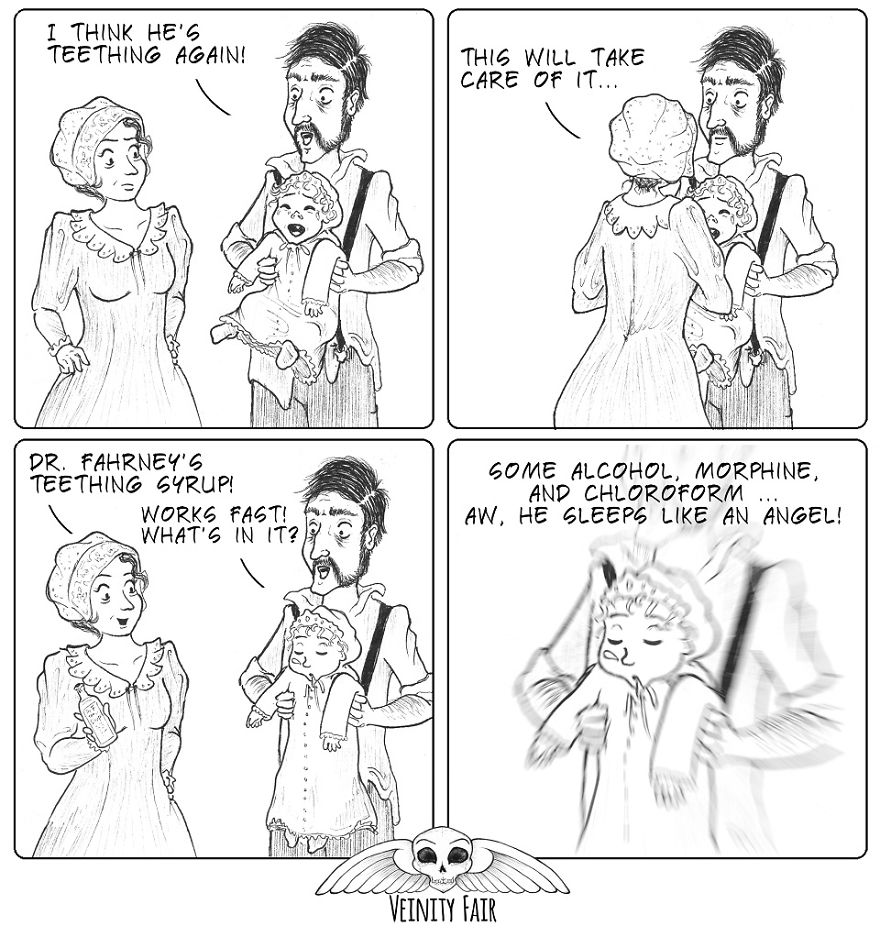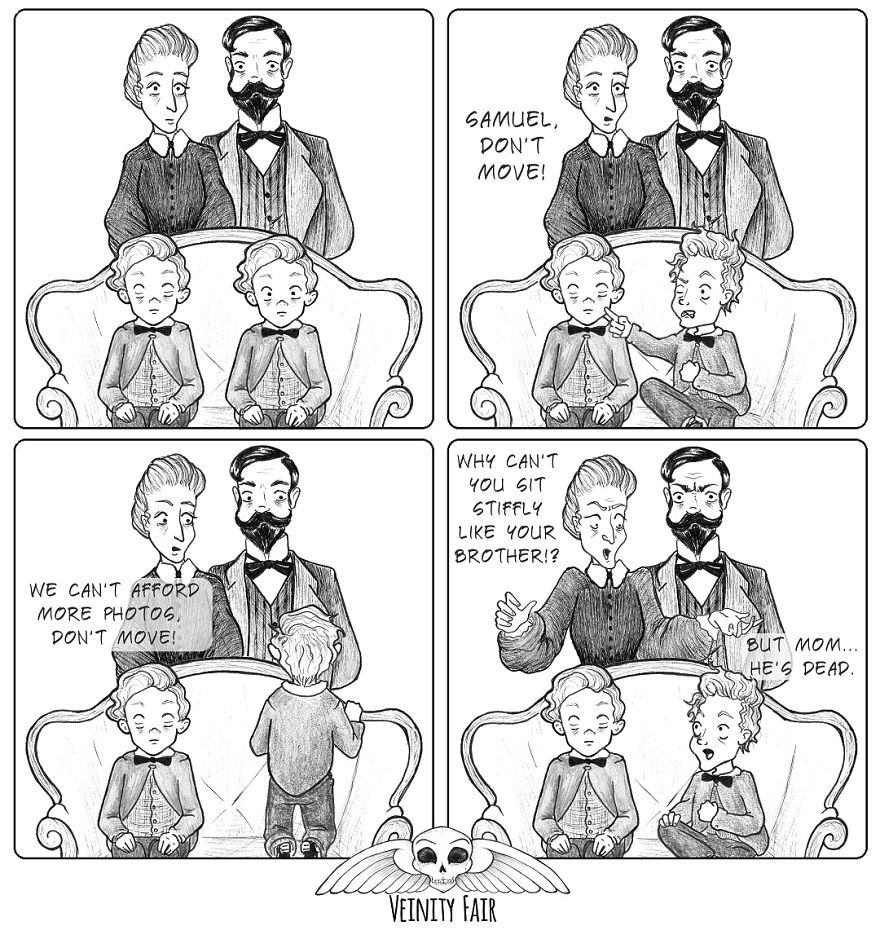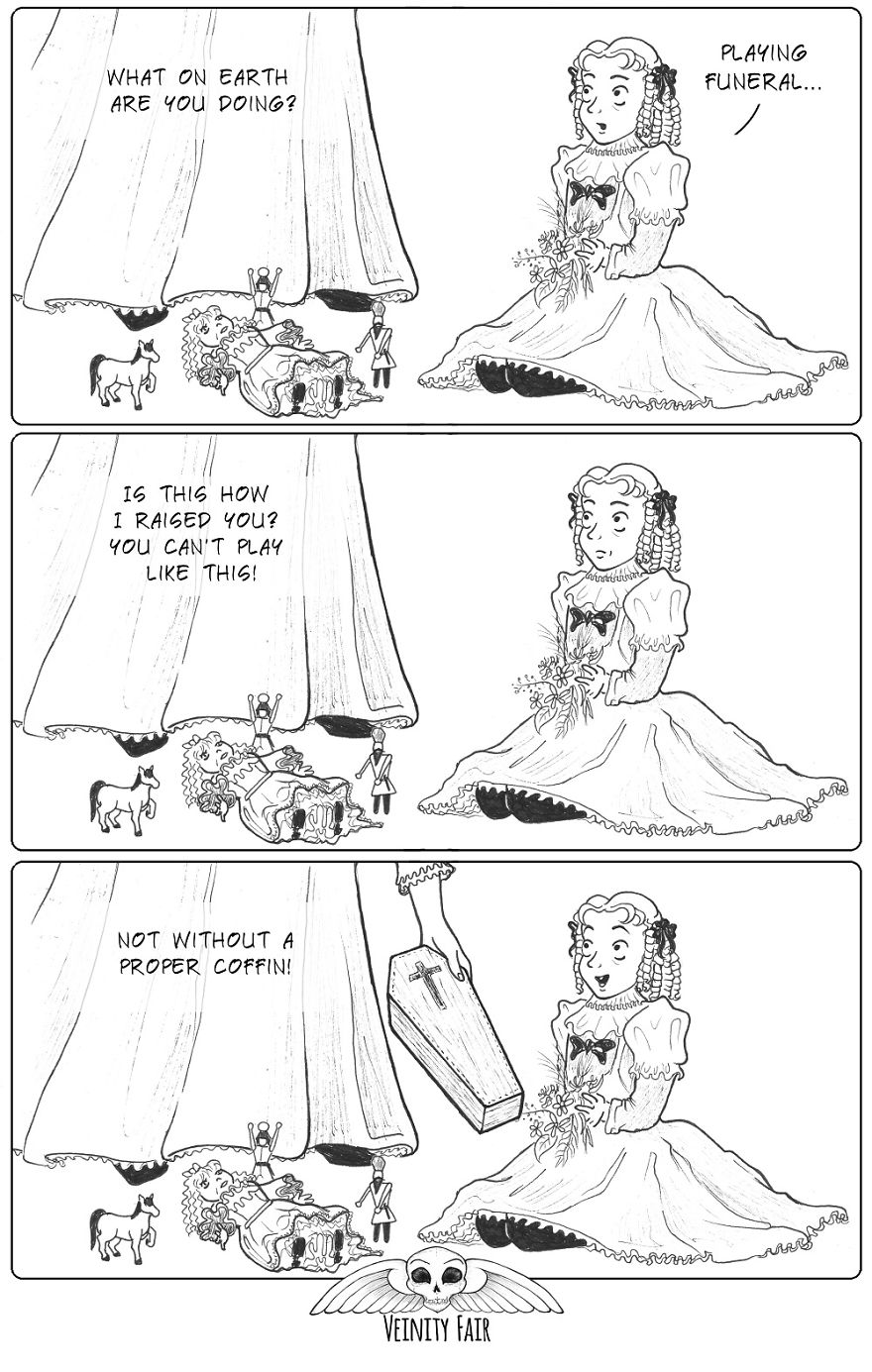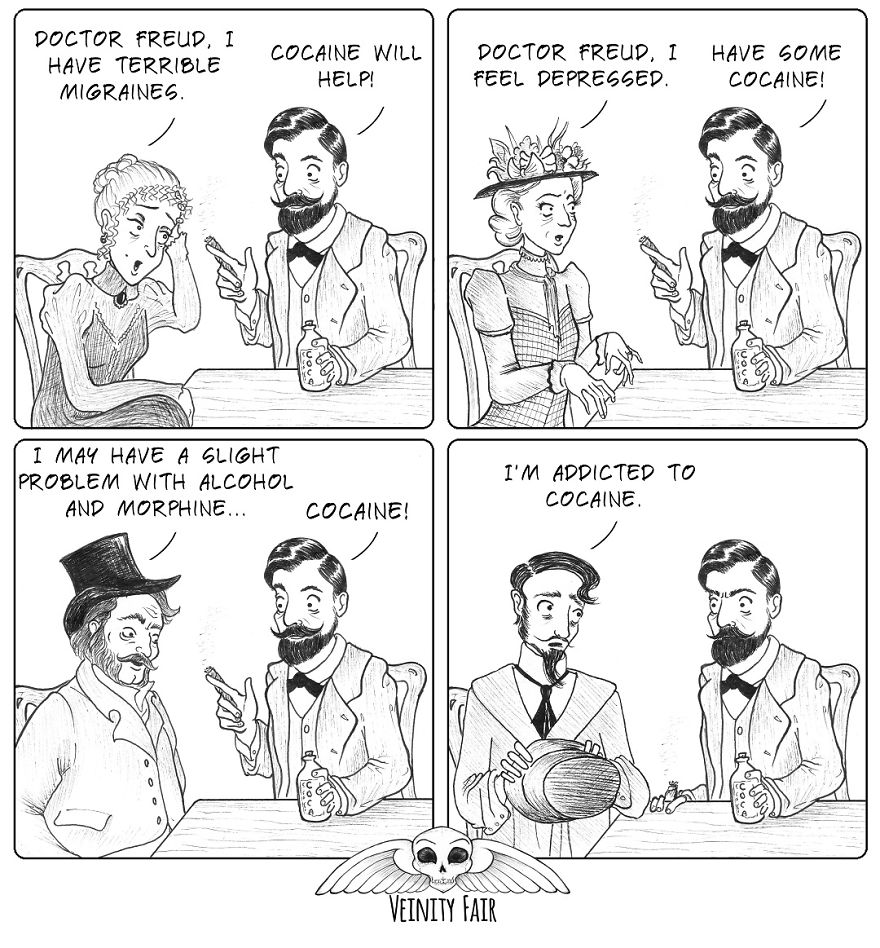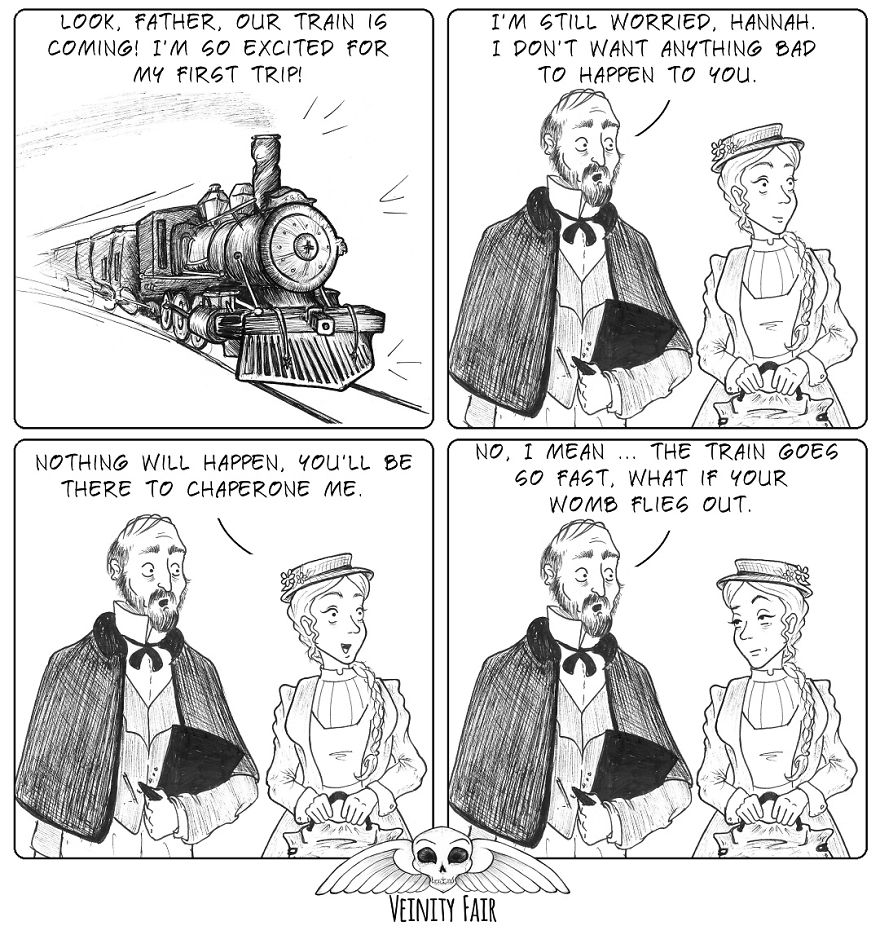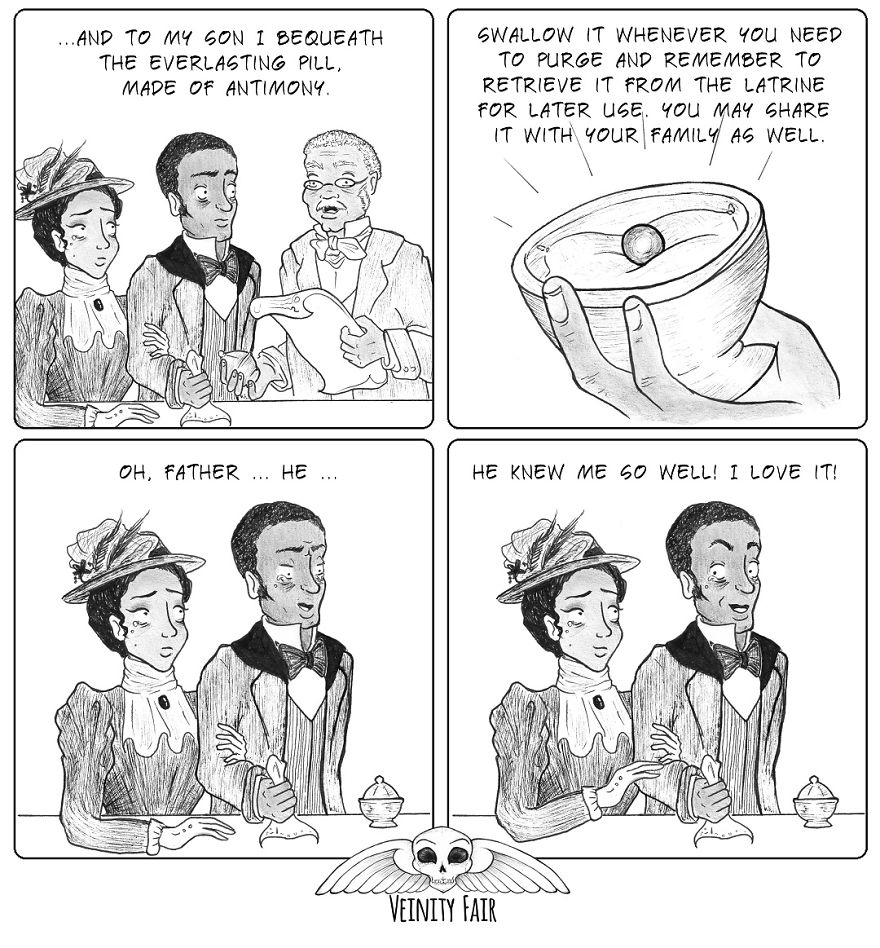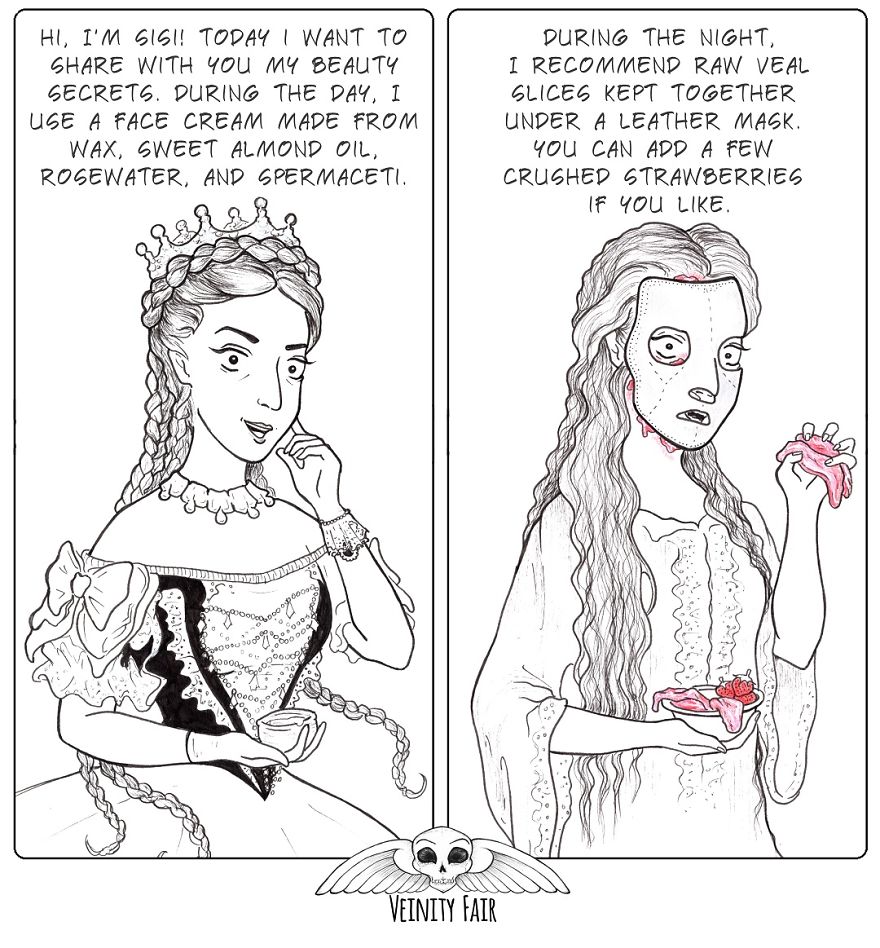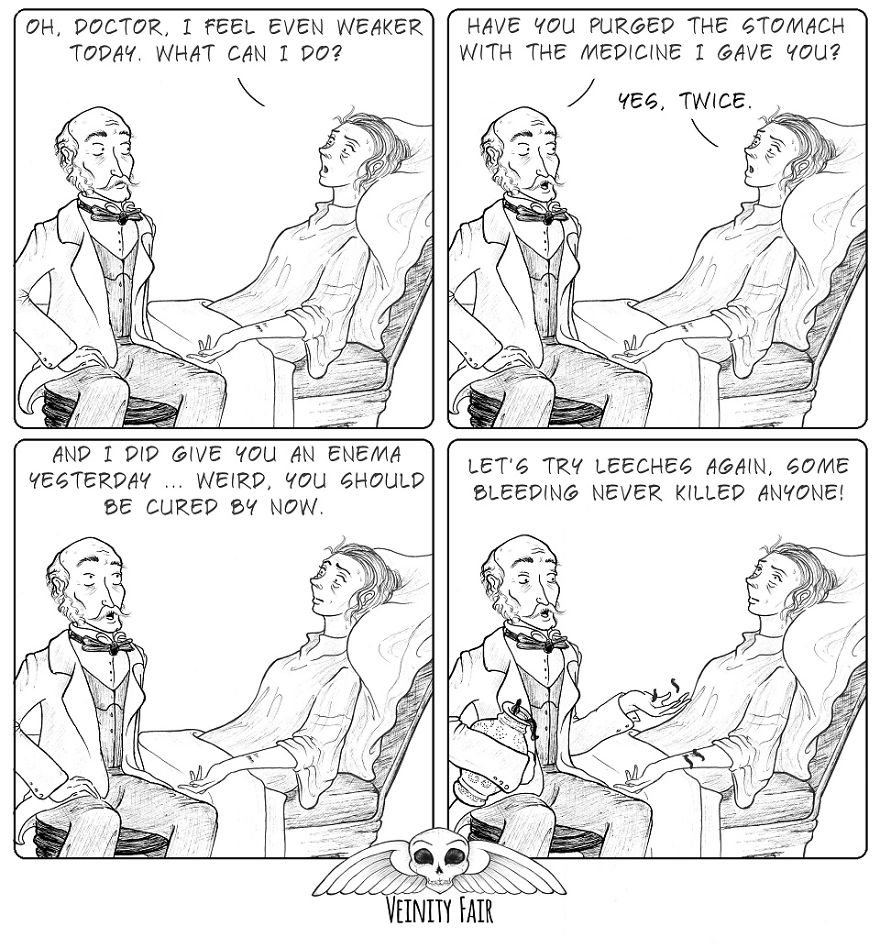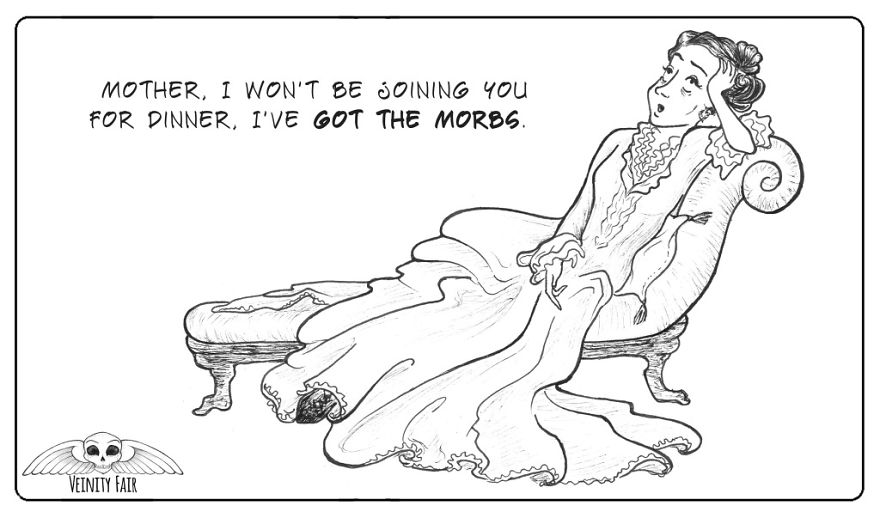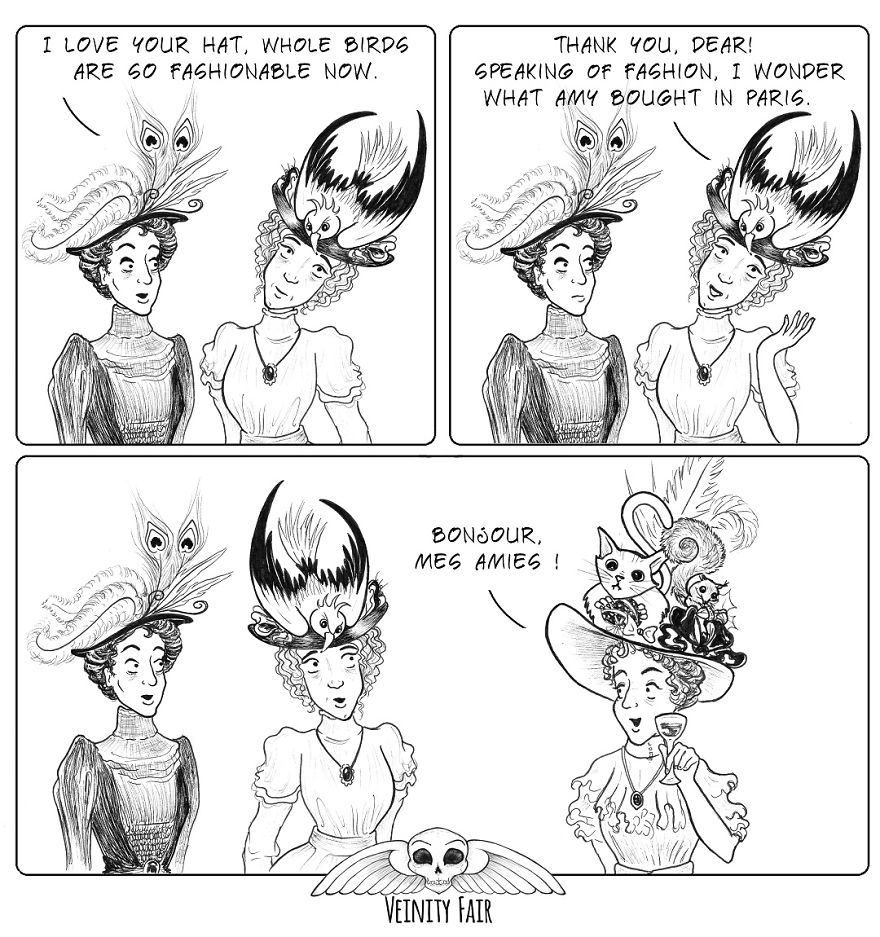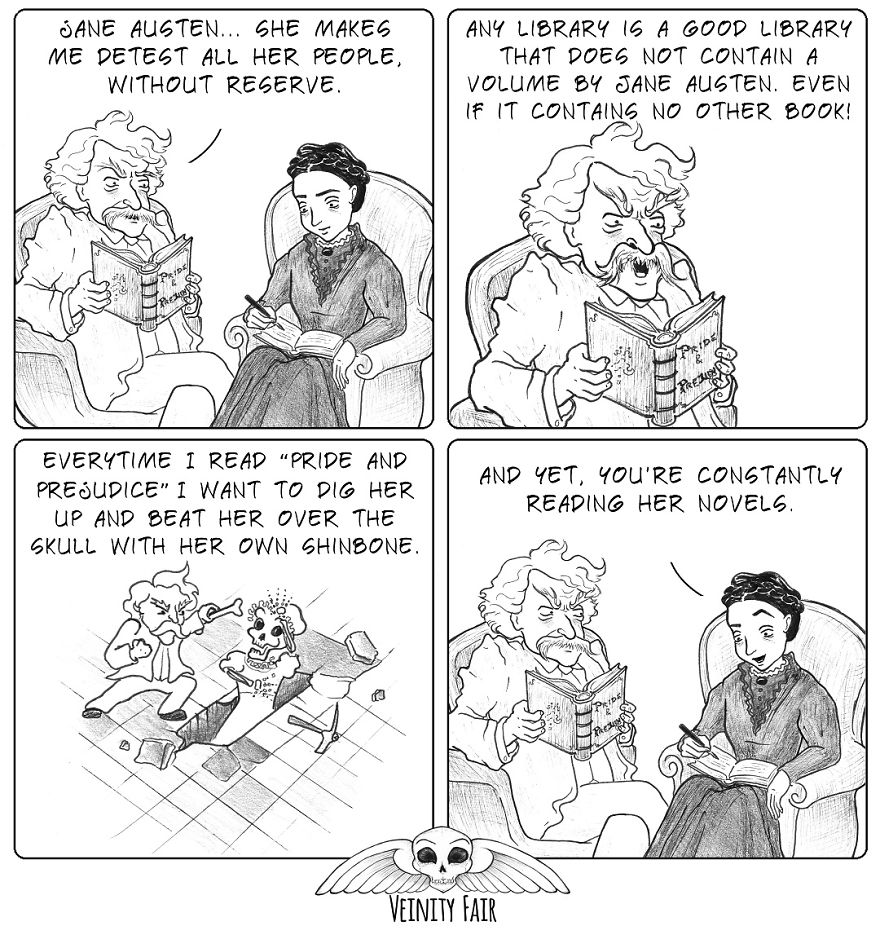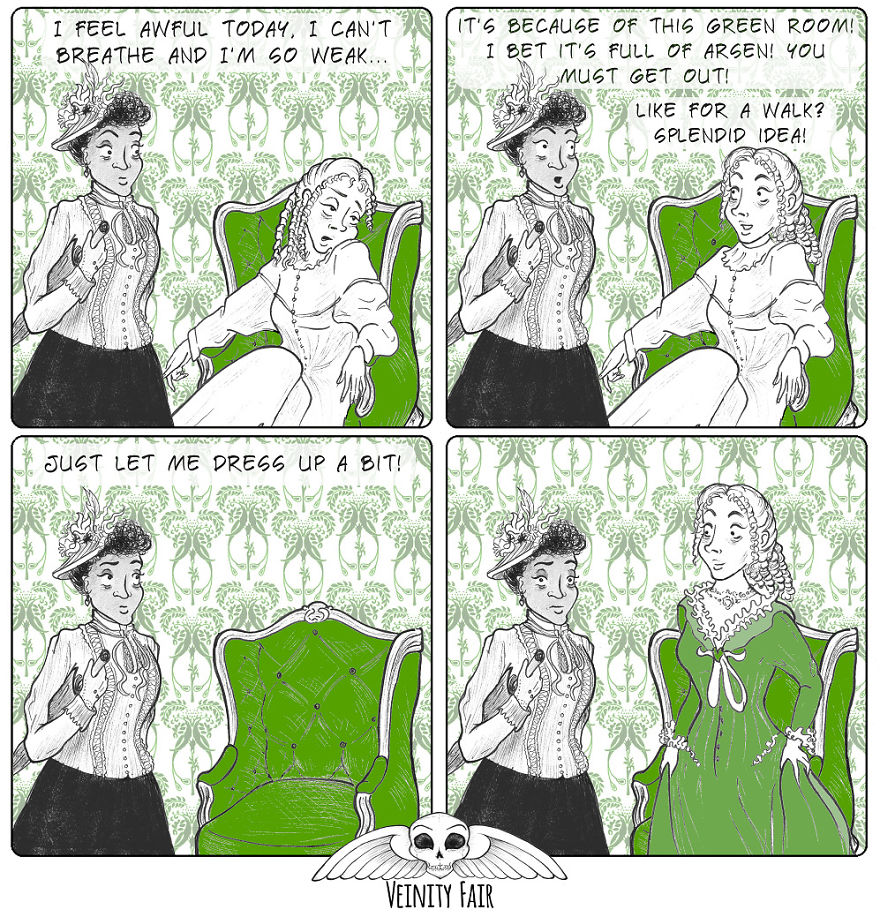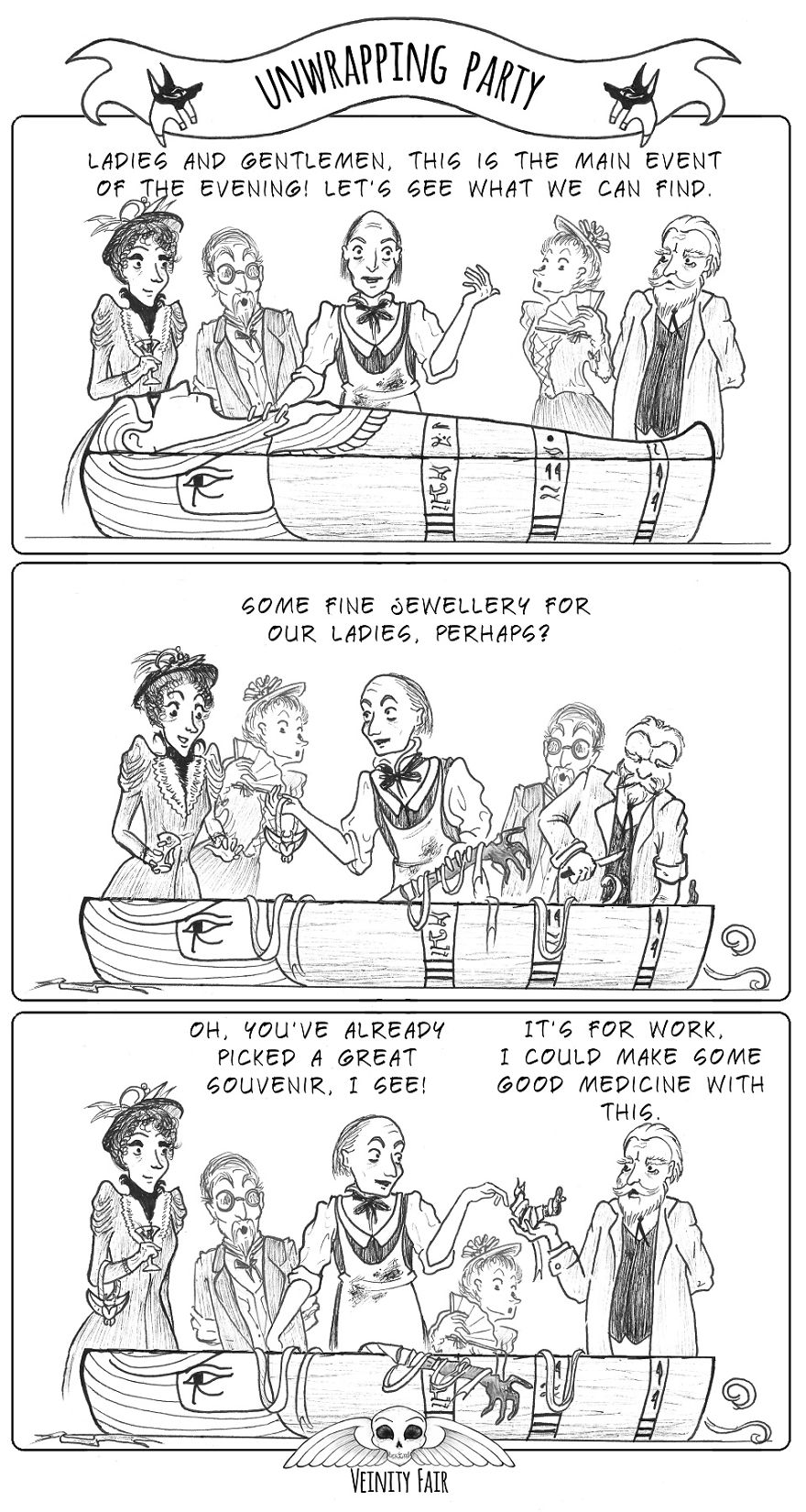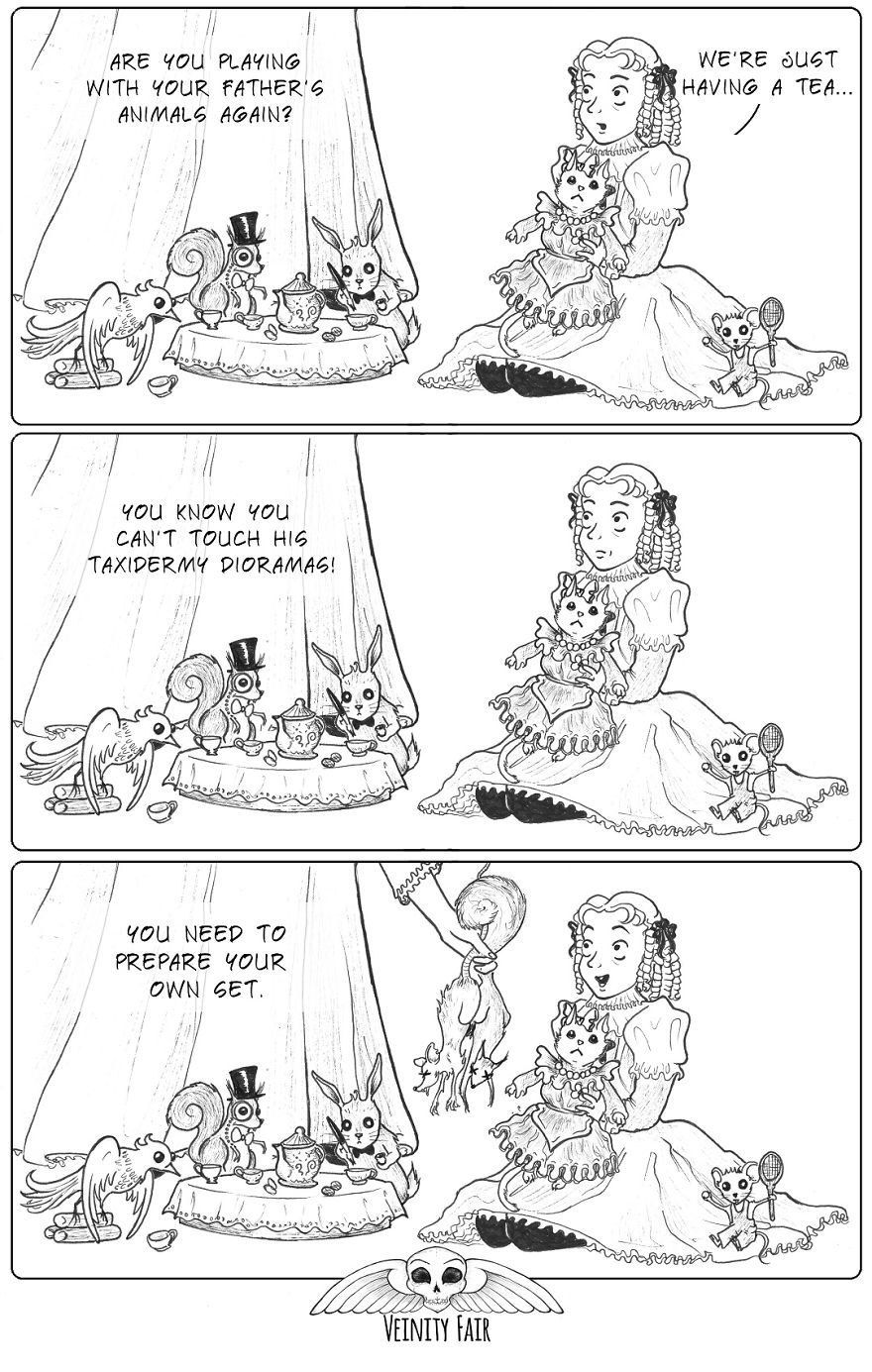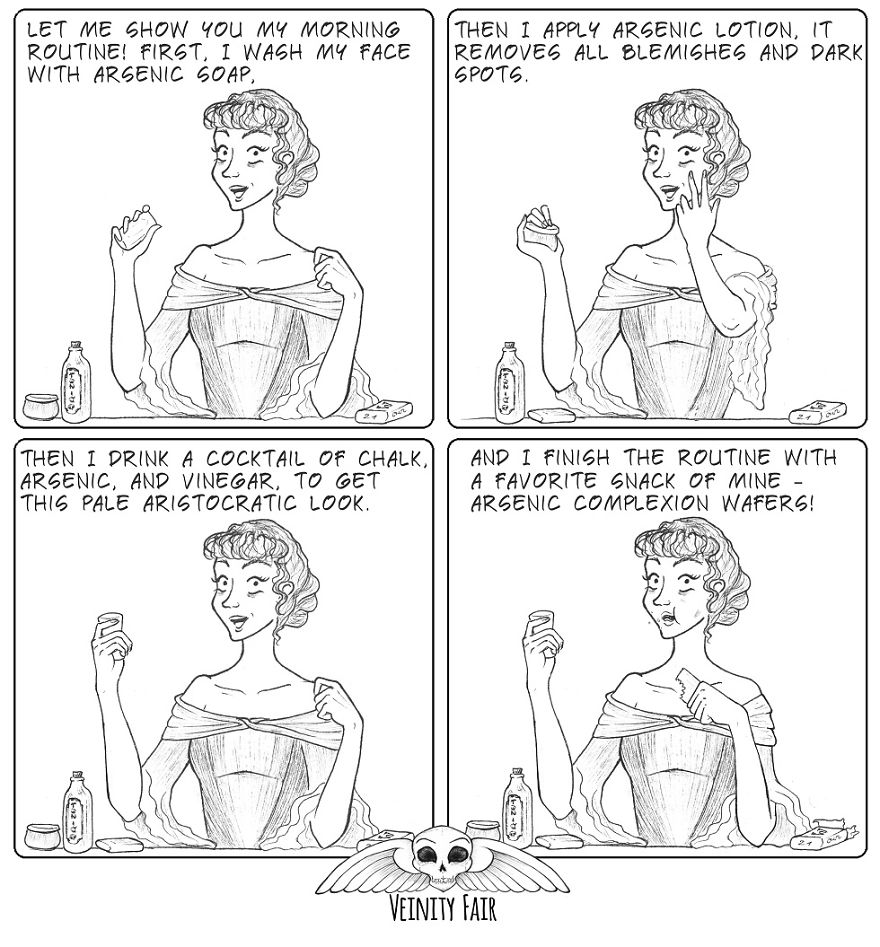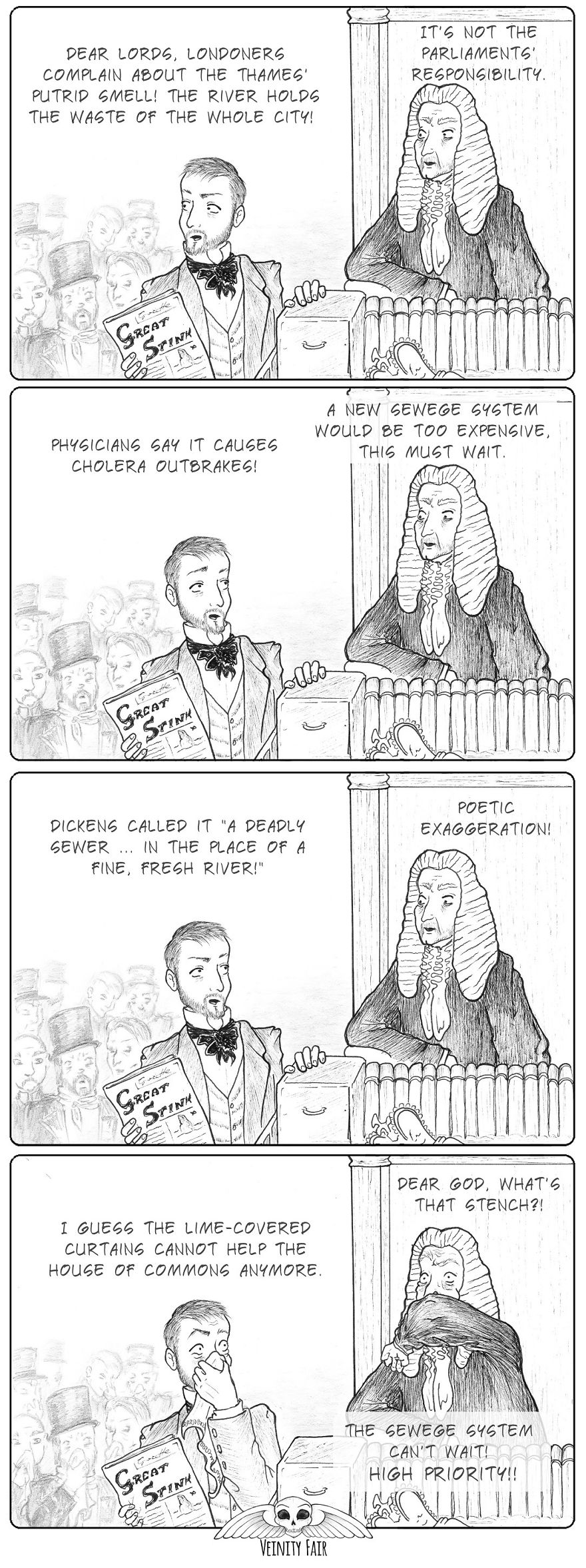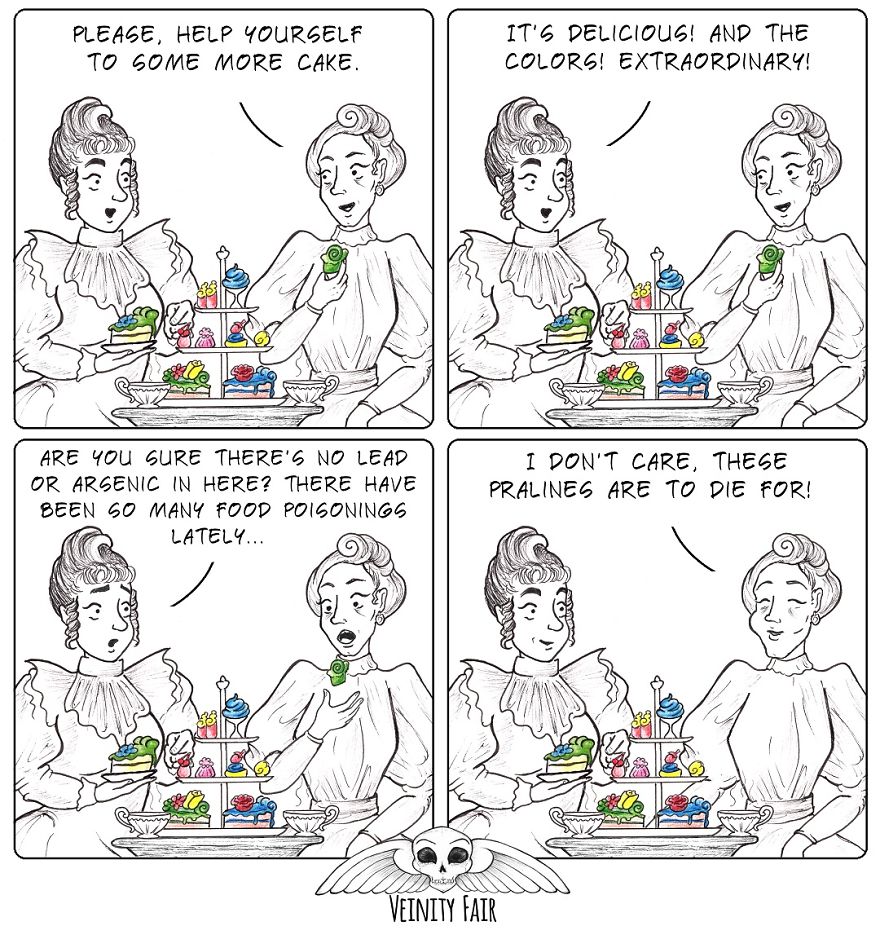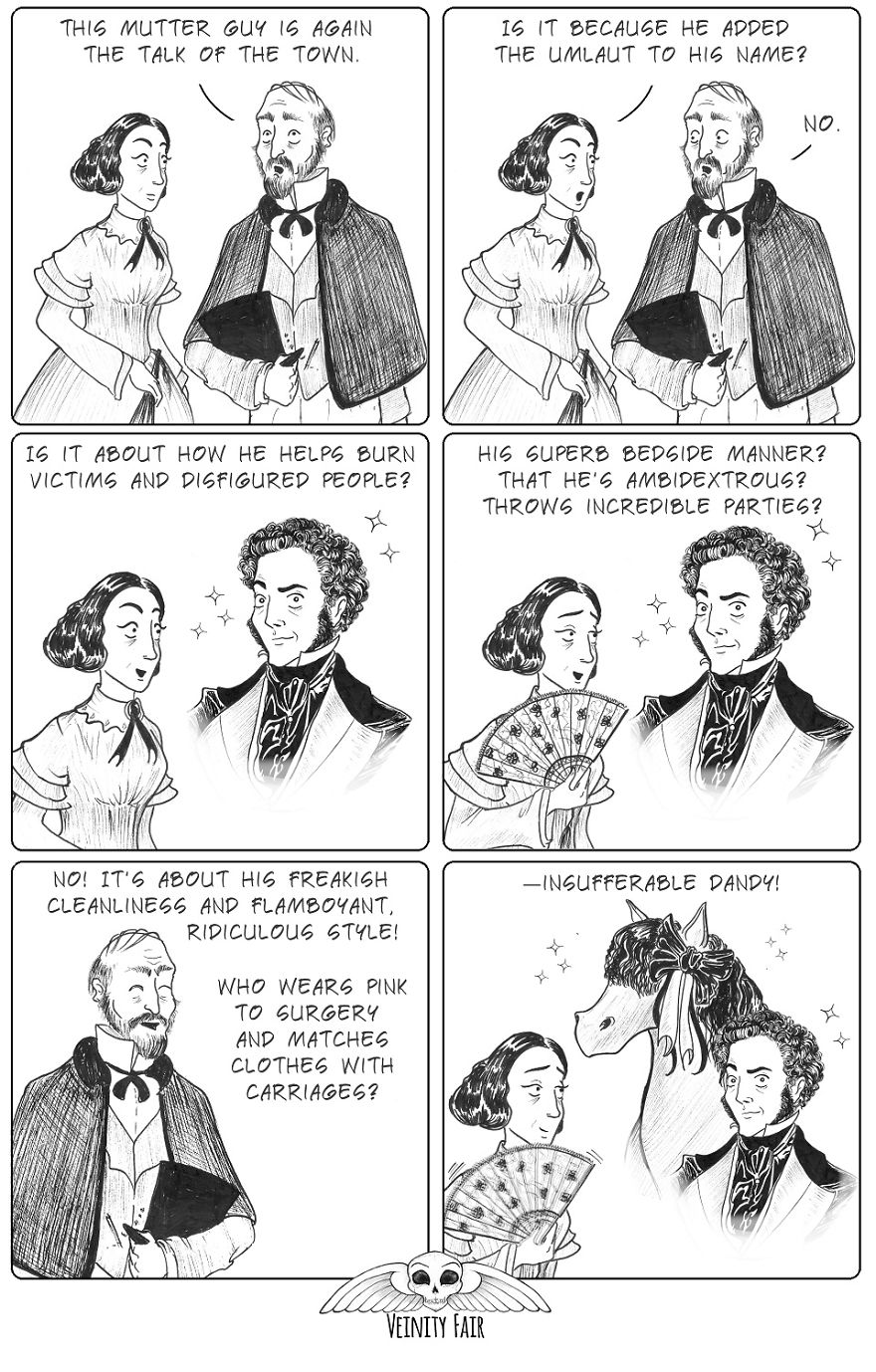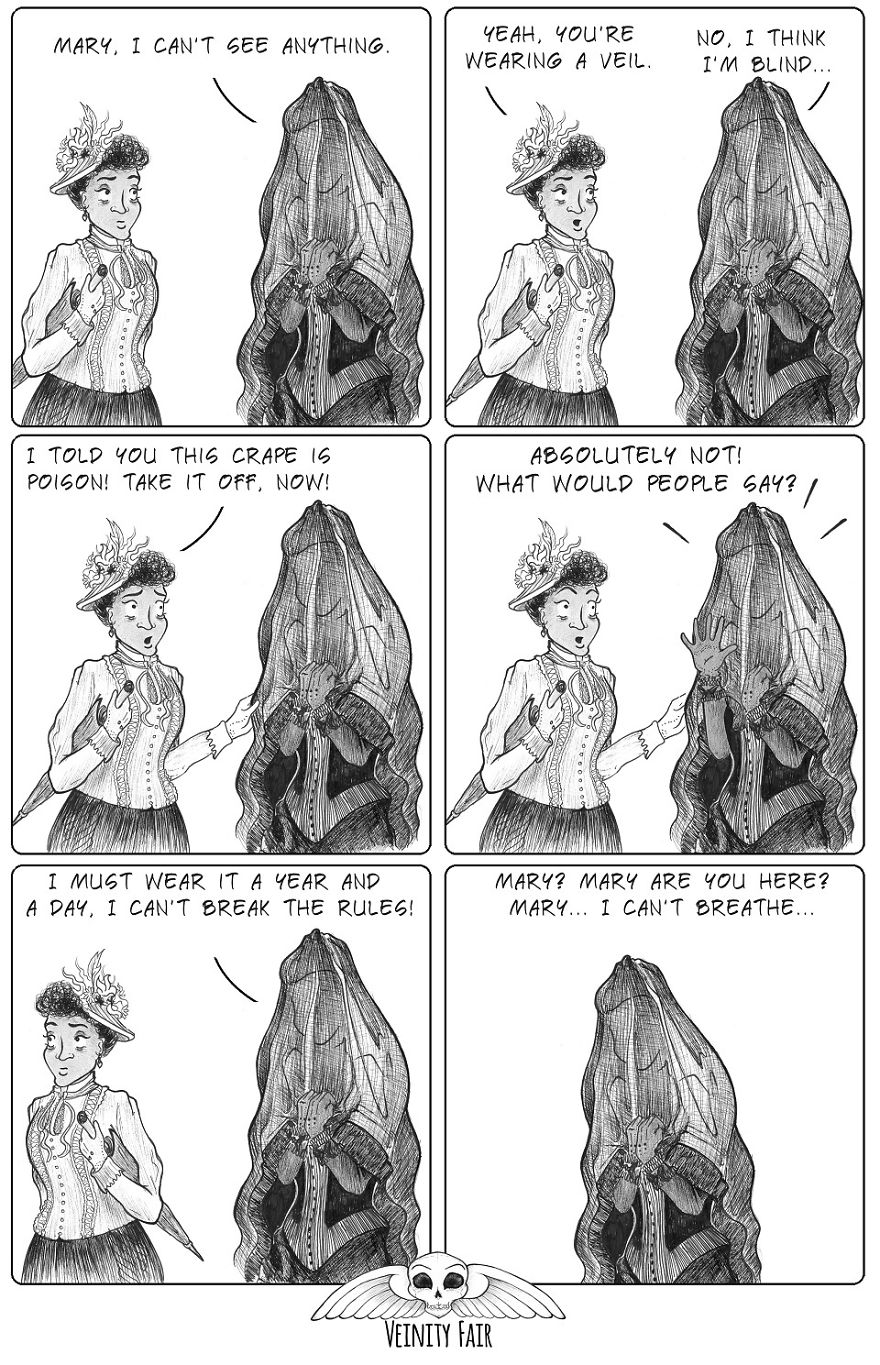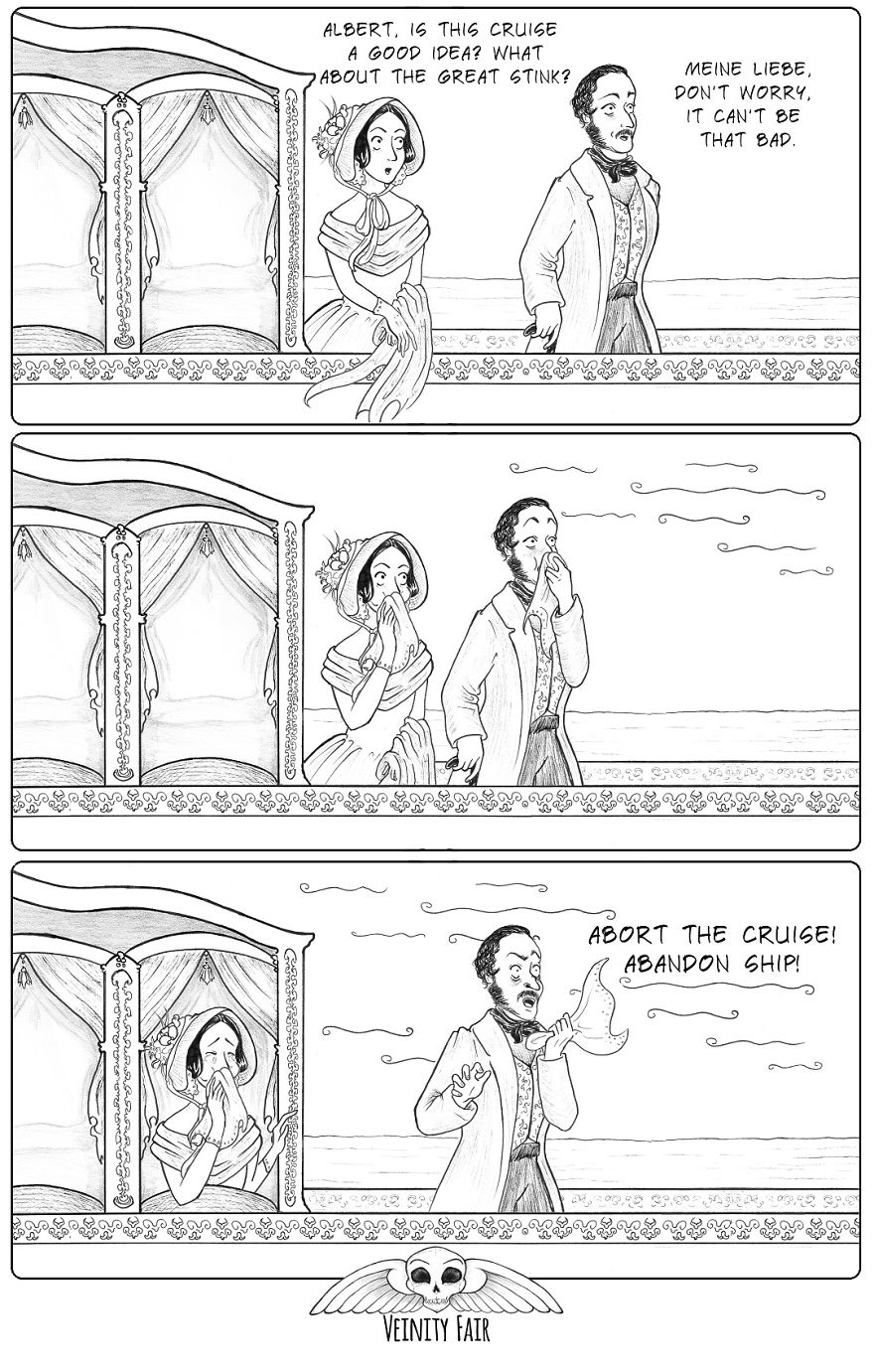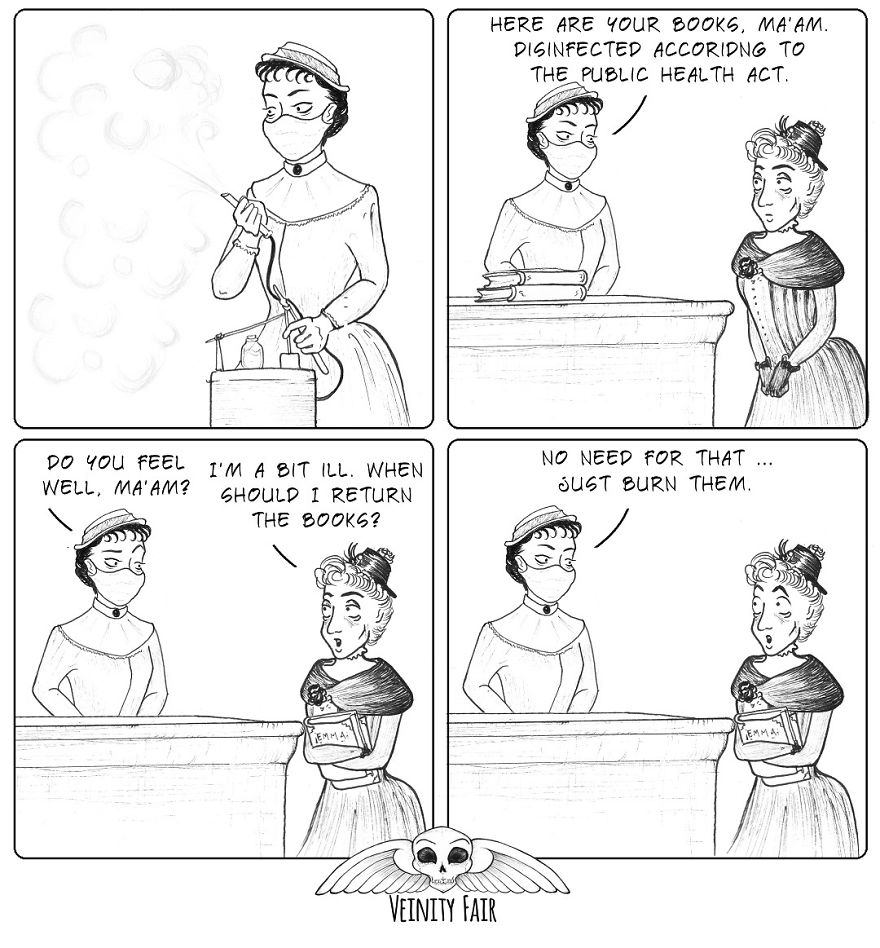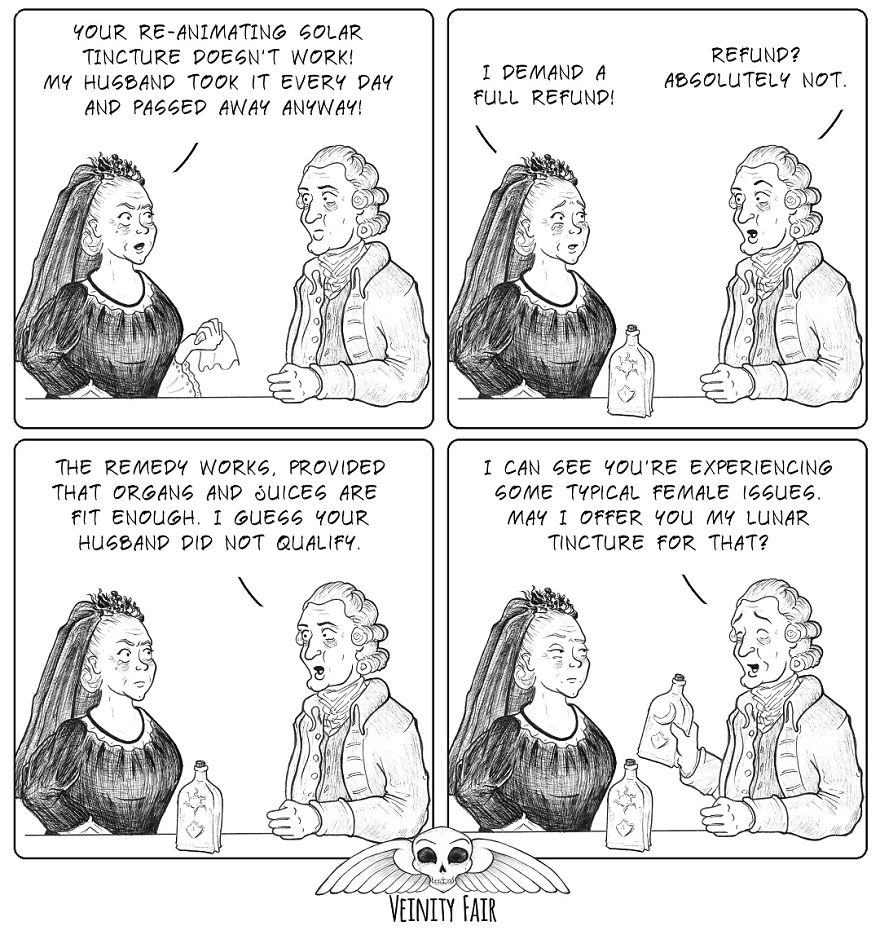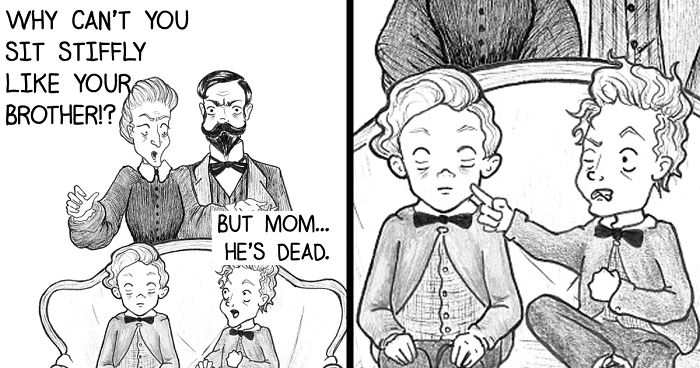
95Kviews
I Draw Comics About Bizarre And Gruesome Facts About The Victorian Era You Might Have Never Heard (22 New Pics)
It's been almost a year since I started Veinity Fair—a webcomic about the bizarre and gruesome parts of Victorian life with a dash of dark humor. During that time, I've drawn over 40 comics (you can check out the first 20 comics in my first Bored Panda article), started a Patreon mini-series on Victorian slang, and met many wonderful people who also love to discuss history and unusual trivia.
Enjoy the new set of comics and follow me on Veinity Fair's social media for the upcoming Halloween-themed comics, resources, and a great community!
More info: Instagram | Facebook | twitter.com | veinityfair.com | patreon.com
This post may include affiliate links.
Dr. Fahrney’s Teething Syrup
Dr. Fahrney’s Teething Syrup was one of the "miraculous" Victorian products that promised to cure everything from teething pain through the common cold to cholera and dysentery.
Advertised as medicine for babies, this concoction included alcohol, morphine, and chloroform.
Post-Mortem Photography
The Victorians are known for their obsession with death and elaborate mourning practices, something that was undoubtedly influenced by the high mortality rate of the times. The invention of the daguerreotype in 1839 allowed them to explore mortality and grief through a new medium—post-mortem photography. Families would have their pictures taken with dead relatives lying peacefully in a bed or, more unusually, posed in a life-like manner on a chair. Some resources even claim that special metal constructions could be used to make the corpses 'stand" for the photo, however, this is more likely just a myth fueled by misinterpreted 19th-century pictures. While post-mortem photography might seem morbid today, it's worth remembering that these photos were often the only images that people had of their loved ones: first photographs were costly, not easily available, and required long exposure time.
Playing Funeral
While it might seem morbid today, children playing funeral were not a rare sight in the Victorian era. It was a reflection of the times—high mortality rate meant that children often witnessed death in their families, not only of grandparents and parents but also siblings. Special doll sets containing small coffins and mourning fabrics were sometimes given to girls, who would then practice dressing the doll, laying it in the coffin, and performing other tasks connected with a funeral, like attending the mourners.
“Might seem morbid today” have you met kids? They still play games like this.
I knew a girl in 4th grade who decided to have a "funeral" in school. I made a farewell card for her. XD!
Load More Replies...i have always played funeral with my siblings, but it always ended with the dead rising and having unnatural superpowers
Freud And Cocaine
Sigmund Freud, best known as the father of psychoanalysis, spent a large portion of his life promoting cocaine as a miracle cure for almost everything. Not only did he prescribe cocaine to his patients, but also used it himself on a regular basis. Some scholars believe this has largely influenced his theories on the human psyche and treatments which are considered pseudoscientific today.
Flying Wombs
The advent of the steam-powered locomotive allowed people to travel farther and faster than ever before and quickly became popular with the public. However, the freedom which came with this form of transport was also seen as a moral and physical threat, especially to women.
Some believed that "vulnerable" women's bodies wouldn't handle the high-speed (80 km/h or 50 mph) travels, resulting in faintings, madness, or… uteruses falling out. Therefore women were sometimes discouraged from traveling.
Everlasting Pill
The everlasting pill, also known as a perpetual pill, was a popular 19th-century medicine that was supposed to bring balance to the body's humors by inducing purging. The pills were made of metallic antimony, a highly poisonous substance that causes health effects similar to arsenic poisoning. Why was it called an "everlasting" pill? An antimony pill would pass through the gastric system practically intact, so people would retrieve it, clean it, and put away for later use. Antimony was also a valuable metal at the time, so it was quite common to keep it the family and hand it down from generation to generation.
Princess Sisi
Empress Elisabeth of Austria (1837 – 1898), more commonly known as Sisi, was famous for her extraordinary beauty, lavish hair, and fashion sense. To live up to her own standards, she practiced elaborate beauty routines with the use of a variety of products. Some of these products contained surprisingly weird ingredients…
Cure-Alls
"Clyster, bleed, purge, repeat" could be a motto for many doctors throughout the ages who believed that bad blood, humor imbalance, or miasma were causing all illnesses known to humanity. Such treatments were used as universal cure-alls since ancient times up to the late nineteenth century.
Got The Morbs!
Got the morbs (Soc., 1880)
Temporary melancholia. Abstract noun coined from adjective morbid.
Feather Hats
Fashionistas of the late Victorian and Edwardian eras were obsessed with hats. Particularly with feather hats, adorned with bird feathers, heads, wings, and even whole animals. The demand for birds was so high that the millinery industry decimated dozens of species and even drove one of them – the passenger pigeon – into extinction. The last passenger pigeon died in captivity in 1914.
As taxidermy was a popular Victorian pastime, it is said that not only birds, but also other animals such as squirrels, mice, and even cats fell victim to the over-the-top hat fashion. In 1883, The New York Times published an article on French fashion stating that "The demand for kittens' heads has become so important that cat breeding has become a regular business." To be fair, it seems to be exaggerated as there isn't much evidence of cats being popular hat accessories.
Mark Twain
Apparently, Mark Twain really didn't like Jane Austen. Here are a few things he wrote about her.
Scheele’s Green
Scheele’s Green, also known as copper arsenite, was the name of a green coloring that was used in everything from wallpaper through dresses to toys and candies.
Thanks to the unique, vibrant look it quickly became a very fashionable color. As you can imagine, the arsenic-loaded dye was very dangerous to people’s health, especially if digested or breathed in. The latter could occur as a result of, e.g., molding wallpaper which would release arsine gas.
Unwrapping Parties
The Egyptomania that took over Europe in the 19th century caused a few disturbing trends in society. One of them were so-called unwrapping parties, during which people would observe or even take part in unwrapping ancient mummies, stealing the valuables they could find, or even dissect what was left of the body for "souvenirs" or magic-like medicine. Such parties were supposedly happening in London.
While some scholars today question whether such parties really happened, we can be quite sure that at least one person — surgeon Thomas Pettigrew — was fond of such gatherings, turning them into bizarre shows.
Taxidermy
Many Victorians treated taxidermy as a regular pastime, appropriate for people of all ages. At first, stuffed animals appeared in the parlors as the evidence of the given homeowners' hunting skills, interest in natural history, or simply a part of a larger collection of unique items. While most of the specimen were prepared by hired specialists, taxidermy courses for the general public became quite popular as well. Then near the end of the 19th century, a new form of the hobby entered the scene; anthropomorphic taxidermy. In this style, the mounted animals were posed and dressed in a human-like fashion. The animals also "performed" various activities, for example, playing cards, dancing or getting married.
Although the most famous taxidermists of the time were men (e.g. Walter Potter ), it is worth remembering that the hobby was enjoyed by many women, who were already used to dealing with dead animals in the kitchen or work.
Arsenic Routine
Many Victorians wanted to have a very pale complexion which was supposed to give them a more "aristocratic" look. Because of that, companies started to add arsenic to various cosmetics, including soaps, lotions, and powders. Arsenic was also advised to be ingested, either in the form of wafers (e.g. Dr. Rose’s Arsenic Complexion Wafers) or fluids (e.g. Fowler’s Solution).
Interestingly, prolonged use of arsenic actually darkens the skin, which suggests that the producers might have skimped on the arsenic quantity in their products, thus making them a little bit less deadly.
The Great Stink
The summer of 1858 was exceptionally hot for Londoners—the temperatures averaged 34–36 °C (93–97 °F) in the shade, reaching even 48 °C (118 °F) in the sun. This unbearable weather was however overshadowed by something even more unbearable: the Great Stink.
The source of this unbelievable stink was the Thames, which served as a sewer for all human, factory, and slaughterhouse waste in the area. As the London population doubled in the first half of the 19th century, so did the problems surrounding the river that served as the main source of "fresh" water. Apart from the offensive smells, Thames was also the source of cholera outbreaks and other diseases. The situation was dire and a prominent engineer called Joseph Bazalgette created plans for a new sewerage system. His plans weren't accepted by the government, which even suggested that cleaning up the river wasn't really their problem, even though they had to use scented handkerchiefs, tobacco, and curtains covered with chloride of lime to protect themselves from the putrid smells in the Palace of Westminster.
When the Great Stink of 1858 knocked at the House of Commons' doors, there was no excuse to postpone dealing with it any longer. As the level of the river dropped because of the heatwave, "a huge pile of human waste was left piled up right next to Parliament." Benjamin Disraeli described it as a “Stygian pool, reeking with ineffable and intolerable horrors” and proposed a bill supporting the modernization of the sewer system based on the Bazalgette's plans.
Food Coloring
In mid-19th-century England three things became quite common: the five o'clock tea, sugar consumption, and the use of food coloring. This mix could become quite deadly when an afternoon tea hostess would buy ready-made sugar cake decorations. Why? At the time the most vibrant and thus the most eye-pleasing food colors were achieved by adding some pretty dangerous stuff, e.g., copper sulfate for blue, copper arsenite for green, or mercury sulfide for red. Also, lead was added to achieve different shades depending on the formula. Many people got seriously sick and some even died because of the coloring in their sweets. In 1851 nearly 200 people were poisoned by colored lozenges, 17 of whom fatally. This and other fatal events finally led to the passing the Adulteration of Food and Drink Act of 1860, one of the first focused on food safety.
Thomas Dent Mütter
Doctor Thomas Dent Mütter was an exceptional surgeon who pioneered many techniques that helped burn victims and people with extreme deformities, labeled by others as lost causes and "monsters" (it was a medical term at the time!).
Mütter himself suffered from several illnesses throughout his life, which made him very sympathetic to patients' lot. He used to explain the procedures to patients and prepare them for surgeries both physically and mentally. He boasted to be one of the fasted surgeons in the U.S., an important feature in the pre-anesthesia times, and wrote a book on special techniques used during such surgeries. This didn’t prevent him from becoming the first surgeon to administer ether anesthesia in Philadelphia and adapt his methods over time according to the newest discoveries.
Mütter was also a colorful figure known for extravagant style and expression, something that Europeans loved about him and many Americans… not so much. Today he's best known for an enormous collection of medical specimen and oddities you can visit in Philadelphia.
"Monster" was a medical term into the 1950s. Saw it in an OB/GYN manual published in 1954. It was referring to children born with micro encephalitis
Crape Veils
Victorian mourning veils were popular accessories worn by grieving women. The veils could be as long as six feet and were traditionally made out of black crape, a scratchy fabric believed to be the most appropriate for mourning.
Unfortunately, some of the black dyes (like logwood dye) used in the production were quite poisonous, causing a variety of ailments from light rashes to serious respiratory problems. Widows were especially affected by these dangers as the Victorian society expected them to wear crape veils for at least a year and a day during the so-called deep mourning stage.
Victoria And Albert's Cruise
In the summer of 1858, Victoria and Albert took a leisurely cruise down the Thames, unprepared for the severity of the Great Stink. It is said that they lasted on board only a few minutes, despite bringing scented handkerchieves with them.
The Great Book Scare
The Great Book Scare was a period between 1880 and 1920 when the general public was obsessed with the idea that library books were a major source of epidemics.
Even though the evidence for this was small, especially compared to other potential disease sources, many in the U.S and the U.K. believed that library books could spread everything from tuberculosis to smallpox. The authorities and doctors alike started to come up with ideas on how to limit the risk such as treating books with vapors from heated carbolic acid crystals, using formaldehyde, and… just completely destructing books if they had come into contact with a sick person.
Re-Animating Solar Tincture
"RESTORATION of LIFE in CASES of SUDDEN DEATH.—For this benevolent purpose, Dr. SIBLY’s RE-ANIMATING SOLAR TINCTURE, supersedes every art and invention. In all circumstances of suicide, or sudden death, whether by blows, fits, falls, suffocation, strangulation, drowning, apoplexy, thunder and lightning, assassination, duelling, &c., immediate recourse should be had to this medicine, which will not fail to restore life, provided the organs and juices are in a fit disposition for it, which they undoubtedly are much oftener than is imagined."
This is how Dr. Sibly advertised his Solar Tincture in the 1790s and early 19th century. A miracle cure that could cheat Death himself! While buying such a remedy seems ridiculous, many people could have been inclined to do so given the high mortality rate of the times, popular fear of being buried alive, and Sibly's medical title (even though he had bought his degree).
Another cure-all from Dr. Sibly's shelf was the Lunar Tincture. It was supposed to be the answer to all female problems, which according to Dr. Sibly were caused mainly by the lack of sex, too much sex, menstruation, lack of pregnancy, or menopause.
This comic should be required reading for all anti-science, anti-technology, and superstitious crackpots. Bloodletting, arsenic soap, and the everlasting pill. This is what their world of ignorance looks like
Not that I'd agree with them but they'd probably use these comics as 'proof' that doctors aren't always right and that science doesn't hold all the answers. There's no reasoning with people who don't want to hear reason.
Load More Replies...Enjoyed this. They had some really off the wall ideas. Before we start feeling to superior though consider what our ideas will look like 200+ years from now.
More please, I died as soon as I saw this, These were really fascinating
A sudden death you say. You, my friend, are in need of Dr. SIBLY’s RE-ANIMATING SOLAR TINCTURE.
Load More Replies...https://www.npr.org/sections/health-shots/2015/01/12/375663920/the-doctor-who-championed-hand-washing-and-saved-women-s-lives
This is a story about a doctor. At the time (1800s) there was only one way to learn about how a person's anatomy works. By opening them up. This hardworking and eager doctor took over the maternity segment of a hospital from a lazy doctor and strangely the number of deaths went up. This was because he had spent the morning cutting up people before going directly to trying to deliver babies... without washing his hands... He becomes a champion for hand washing but at this time he is mostly ignored.
Load More Replies...This is my favorite comic series! Kids playing with dead stuffed animals sounds horrible.
... I kinda did that. But they weren't stuffed, they were just dead and bloody.
Load More Replies...It's odd that they didn't mention how "Female hysteria" was treated in the Victorian age by "pelvic massage". https://www.vintag.es/2019/09/female-hysteria.html
I’m just sad nobody was running around yelling hysteria at the first educated women they see 🤪
How long before the wearing of masks and social distancing is ridiculed as scientific suspicion? It was the science of the day back then.
How long before the wearing of masks and social distancing is ridiculed as scientific suspicion?
Possibly Fun Fact: Callipygous is the primitive-ish fancy semi-synonym of thicc. It means "The quality of having attractive buttocks" or some crap like that, idk really im just repeating somtehing i read in the qi book
If you liked this then I recommend researching Burke and Hare! They were around during the industrial revolution and the tattie famine!
This comic should be required reading for all anti-science, anti-technology, and superstitious crackpots. Bloodletting, arsenic soap, and the everlasting pill. This is what their world of ignorance looks like
Not that I'd agree with them but they'd probably use these comics as 'proof' that doctors aren't always right and that science doesn't hold all the answers. There's no reasoning with people who don't want to hear reason.
Load More Replies...Enjoyed this. They had some really off the wall ideas. Before we start feeling to superior though consider what our ideas will look like 200+ years from now.
More please, I died as soon as I saw this, These were really fascinating
A sudden death you say. You, my friend, are in need of Dr. SIBLY’s RE-ANIMATING SOLAR TINCTURE.
Load More Replies...https://www.npr.org/sections/health-shots/2015/01/12/375663920/the-doctor-who-championed-hand-washing-and-saved-women-s-lives
This is a story about a doctor. At the time (1800s) there was only one way to learn about how a person's anatomy works. By opening them up. This hardworking and eager doctor took over the maternity segment of a hospital from a lazy doctor and strangely the number of deaths went up. This was because he had spent the morning cutting up people before going directly to trying to deliver babies... without washing his hands... He becomes a champion for hand washing but at this time he is mostly ignored.
Load More Replies...This is my favorite comic series! Kids playing with dead stuffed animals sounds horrible.
... I kinda did that. But they weren't stuffed, they were just dead and bloody.
Load More Replies...It's odd that they didn't mention how "Female hysteria" was treated in the Victorian age by "pelvic massage". https://www.vintag.es/2019/09/female-hysteria.html
I’m just sad nobody was running around yelling hysteria at the first educated women they see 🤪
How long before the wearing of masks and social distancing is ridiculed as scientific suspicion? It was the science of the day back then.
How long before the wearing of masks and social distancing is ridiculed as scientific suspicion?
Possibly Fun Fact: Callipygous is the primitive-ish fancy semi-synonym of thicc. It means "The quality of having attractive buttocks" or some crap like that, idk really im just repeating somtehing i read in the qi book
If you liked this then I recommend researching Burke and Hare! They were around during the industrial revolution and the tattie famine!
